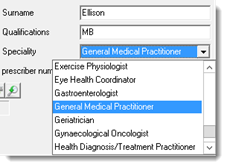Demographics overview
Only those patients who meet the required Indigenous status, record status, patient status, age, or address are included in the reporting.
Indigenous status
- Aboriginal but not Torres Strait Islander
- Torres Strait Islander but not Aboriginal
- Both Aboriginal and Torres Strait Islander
Any exceptions are stated in the definition for that specific indicator.
- Aboriginal & Torres Strait Islander - includes all patients with one of the above statuses recorded in their biographics.
- Non-Aboriginal - any patient with an Indigenous Status of Neither Aboriginal nor Torres Strait
- Not Recorded - any patient where the Indigenous Status is not recorded, or the Indigenous Status is Not stated/inadequately described or Not applicable.
Record status
- Current
- Transient
- Past
- Banned 30 days
- Banned 60 days
Patients who have a Communicare patient status of Fictitious (either at the time the report is run or at the end of the report period) are excluded. Patients who had a Communicare patient status of Non-Patient at the end of the report period are also excluded.
- Booked
- Cancelled
- Waiting
- Withdrawn
- All no client contact modes
- Administration – client contact
If a patient has at least three such services in the two years preceding the end of the report period and they were still alive at the end of the report period, then they are deemed to be a regular client. However, see the comments in the Residence section below relating to the patient’s home address at the end of the report period and how this relates to use of the Locality Group parameter in Communicare reports.
OSR reporting does not use the Regular Client status. All patient records are included except Fictitious patient records. Non-patient records are included but reported with an Indigenous Status of Not Recorded.
Patient status
For nKPI reporting, all patients with a status of Non-Patient are excluded even if they have three visits in the previous two years.
- If the patient record has an MRN of #GROUP, group activity will be counted but not in the contacts, episodes or individuals reports.
- If the patient record has an MRN of #ANON, any activity is disregarded. This means that the patient record is for anonymous activity and any age, sex or Indigenous status will be unknown so the data cannot be disaggregated.
- If the patient record does not have an MRN of either #ANON or #GROUP, activity will also be disregarded.
- Group activity record: an example is UNIDENTIFIED CLIENTS. If the patient ID has an asterisk, this is currently being used for group activity.
- Anonymous patient record: examples might be NEEDLE EXCHANGE, MALE or WALKIN, UNKNOWN.
- Other non-patient records: these should all be real people but who only attend the health service for specific purposes other than their main health care, such as, dental only patients or ITC patients referred from a private GP for supplementary services. If they should be included in the nKPI reports and the OSR reports, their status must be changed from non-patient.
- To record biographic details of a carer who is responsible for a patient of the health service but who does not attend for their own health care
- To record a real patient who may attend the health service for a single purpose, such as a dental clinic, but who belongs to another health service and does not require any other health service delivery, such as health check reminders, blood tests, chronic disease management, and so on.
- To record anonymous services such as group information sessions, anonymous needle exchange, health promotion events, and so on.
Residence
A patient must have had a home address at the end of the report period. What this means is that a patient added after the end of the report period will not be included even if they have backdated service activity.
- To print a list of all localities within all locality groups, run . Maintenance to these lists is done at .
- To look for omissions and mistakes, run . Tip: Run this report with a range of post codes that covers your health service area completely.The resulting report will show all locality groups and indicate which localities belong to multiple or no such groups. Maintenance to these lists is done at .

Age groups
- 0-4 years
- 5-14 years
- 15-24 years
- 25-34 years
- 35-44 years
- 45-54 years
- 55-64 years
- 65+ years
Where stated in a specific indicator these may vary. For example, child immunisation age groups differ as do antenatal care age groups.
Age is calculated at the end of the report period (unless a specific indicator states otherwise). Patients who died during the preceding two years but who have had three valid services recorded will be excluded.
Contact types

For information about how the Communicare speciality is mapped to the OSR contacts report, see Client Contact Types reference
